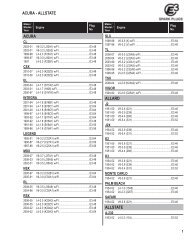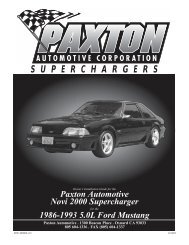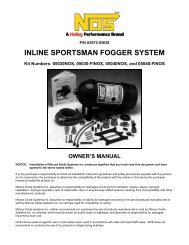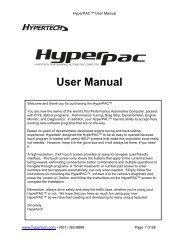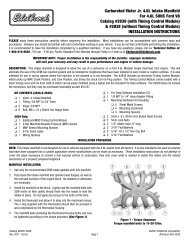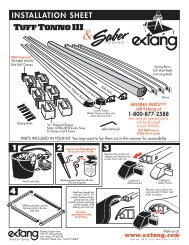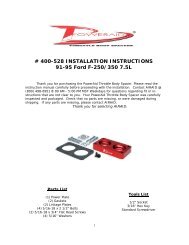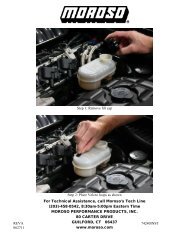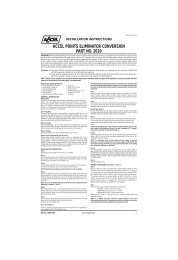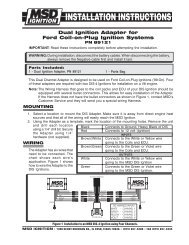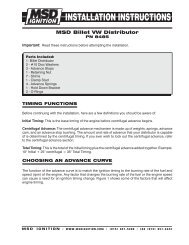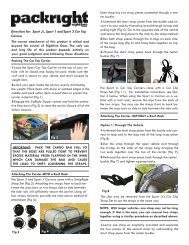Edelbrock 70055 Nitrous System Installation Instructions - Jegs
Edelbrock 70055 Nitrous System Installation Instructions - Jegs
Edelbrock 70055 Nitrous System Installation Instructions - Jegs
You also want an ePaper? Increase the reach of your titles
YUMPU automatically turns print PDFs into web optimized ePapers that Google loves.
2.7 Fuel Solenoid Mounting and <strong>Installation</strong><br />
1. Hold the fuel solenoid securely (like in a bench vise) being careful not to harm the solenoid or block<br />
the inlet or outlet of the solenoid.<br />
2. Install 6AN X 1/4 NPT (Red straight fitting) fuel inlet fitting using liquid Teflon in the inlet port of the fuel<br />
solenoid.<br />
3. Install the red 3AN X 1/8 NPT flare tee using liquid Teflon in the outlet port of the fuel solenoid.<br />
4. Remove fuel solenoid assembly from vise.<br />
5. Attach the universal solenoid mounting bracket to the bottom of the fuel solenoid using 2 of the<br />
solenoid mounting screws.<br />
6. Verify the desired mounting location of the fuel solenoid.<br />
7. Install the fuel solenoid. If the solenoid mounting location is difficult to access, leave the solenoid loose<br />
so the solenoid inlet and outlet port can be easily accessed.<br />
8. Leave the wires loose for the electrical system installation.<br />
2.8 <strong>Nitrous</strong>/Fuel Solenoid Disassembly and Inspection<br />
1. Close the valve on the nitrous bottle.<br />
2. Empty the main nitrous supply line.<br />
3. Remove the solenoid from the engine and securely clamp it to a vise, taking great care not to damage<br />
the solenoid.<br />
4. Remove the solenoid cover retaining nut from the top of the solenoid.<br />
5. Remove the coil and housing from the solenoid base.<br />
6. Unscrew the stem from the solenoid base. Do this by using a solenoid stem removal tool or by “double<br />
nutting” the stem and unscrewing the stem from the housing body. Do not use pliers on the solenoid<br />
stem; damage to the stem will result.<br />
7. Remove the stem, spring and plunger from the solenoid base paying close attention to the way they<br />
are assembled.<br />
8. Examine the plunger seal for swelling, cuts and abrasions. The seal surface should be flat, except for<br />
a small circular indentation in the center of the seal.<br />
Note: A seal that has been contaminated or over-pressurized will bulge from exposure to chemicals<br />
other than fuel or nitrous oxide. It can appear to extend down from the plunger and be dome-shaped.<br />
A contaminated seal may return to its original shape if left out in fresh air for approximately 48 hours.<br />
It may then be returned to service. If it does not return to its original shape, it must be replaced.<br />
9. Clean the solenoid body. Do not use an oil-based solvent to clean any part of the solenoid. Remove<br />
all foreign matter and dirt. Make sure solenoid body is clean, dry and free of oils before assembly.<br />
10. Replace the O-ring, plunger and piston spring.<br />
11. Re-assemble the solenoid by reversing the disassembly procedure.<br />
Catalog #<strong>70055</strong> & #70056<br />
Brochure No. 63-0060<br />
Page 14 of 26<br />
©2002 <strong>Edelbrock</strong> Corporation<br />
Rev. 3/02



